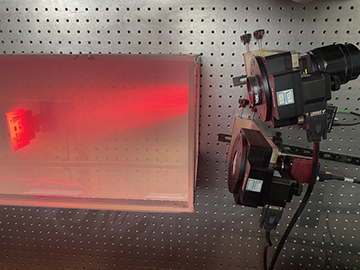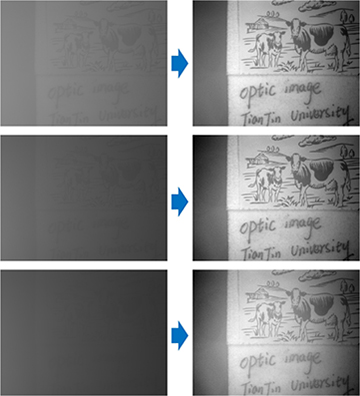
Researchers in China have developed an algorithm that could dramatically simplify and automate the enhancement and clarification of images shot underwater. They tested the model on images gathered using a red LED light source and a CCD camera, imaging targets submerged in water and milk. [Image: Haofeng Hu, Tianjin University]
Taking a clear picture underwater is far more difficult than fashion magazine shots might suggest. When light hits the water molecules or particles suspended in the water, it scatters, distorting the image. And the murkier the water, the greater the problem.
In a new study (Opt. Express, doi: 10.1364/OE.434398), researchers in China announced that they’ve developed an algorithm that enhances the quality of images taken underwater. Unlike conventional processing methods, which require prior knowledge or background information on the imaging area, the new method renders an image without any previous knowledge. That, the authors suggest, can move the imaging community one step closer to automated processing of underwater shots.
From murky to clear
Traditionally, underwater imaging techniques rely on the fact that the scattered light is partially polarized. Using a polarization-sensitive camera can thus mitigate the distortion of underwater images to some degree. For even better results, scientists have been developing processing methods that can further clarify such polarized-light images. These methods, though, force a user to manually select the background area of the picture taken to estimate backscattered light—requiring, in turn, that the image contain enough background area for an adequate selection.
In contrast, the new algorithm developed by the research group at Tianjin University, China, does not require any background selection or previous knowledge of the imaging area. And the algorithm works even when the water is extremely turbid.
To achieve that trick, the researchers began by digging into the math governing the traditional model for recovering an image from polarized-light data. They focused in particular on the equations and routines for optimizing intensity information for backscattered light at two orthogonal polarization directions. The team realized, and showed mathematically, that restricting the analysis to only the “physically feasible” region of light intensity information allowed a variety of intermediate variables to drop out of the calculation.
That, in turn, eliminated the necessity of estimating the intermediate variables—inaccurate estimation of which had been a source of problems in previous methods, and one reason that those methods had required prior knowledge of the imaging area. And it opened up prospects for speeding up and automating the optimization of otherwise murky underwater polarization images.
Efforts to image a submerged target (a drawing on a wooden board) through water of varying turbidity resulted in virtually useless images with a traditional camera (left) and substantially clearer ones using the new method (right). [Image: Haofeng Hu, Tianjin University] [Enlarge image]
LED, camera, water and milk
To put their revised algorithm to a real-world test, the researchers created a simple underwater imaging setup, using a 625-nm (central wavelength) light-emitting diode as the light source, and passing the light through a polarization-state generator to produce horizontally plane-polarized light. That light in turn entered a transparent tank containing an imaging target submerged in water, with varying amounts of milk dissolved in the water to achieve varying degrees of turbidity. Reflected and scattered light from each experiment passed back out of the tank and through a polarization state analyzer, allowing horizontally and vertically polarized images of the scene to be captured using a CCD camera.
Not surprisingly, the unprocessed images of the submerged targets showed essentially no data, as the water-and-milk mixture was sufficiently cloudy to allow no real visibility. When the team passed the data through its algorithm, however, the resulting images recaptured the original detail—with far less noise than when the same targets were imaged and processed using alternative, previously developed cleanup methods.
Automated future
By eliminating a step that requires a manual human involvement, the new method is expected to help researchers automate the whole process. At the same time, “We think the principle we used might be extendable to imaging through other scattering media such as fog, haze and smoke,” the team leader, Haofeng Hu, said in a press release accompanying the research.
The group also hopes to test its method in real-life environment such as the ocean. This could, the press release noted, aid the search for drowning victims, investigations into submerged archaeological artifacts, and observing underwater farms.

